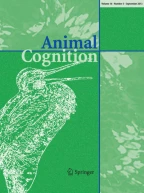Abstract
In previous studies claiming to demonstrate that great apes understand the goals of others, the apes could potentially have been using subtle behavioral cues present during the test to succeed. In the current studies, we ruled out the use of such cues by making the behavior of the experimenter identical in the test phase of both the experimental and control conditions; the only difference was the preceding “context.” In the first study, apes interpreted a human’s ambiguous action as having the underlying goal of opening a box, or not, based on that human’s previous actions with similar boxes. In the second study, chimpanzees learned that when a human stood up she was going to go get food for them, but when a novel, unexpected event happened, they changed their expectation—presumably based on their understanding that this new event led the human to change her goal. These studies suggest that great apes do not need concurrent behavioral cues to infer others’ goals, but can do so from a variety of different types of cues—even cues displaced in time.
Similar content being viewed by others
References
Boesch-Achermann H, Boesch C (1993) Tool use in wild chimpanzees: new light from dark forests. Curr Dir Psychol Sci 2:18–21. doi:10.1111/1467-8721
Buttelmann D, Carpenter M, Call J, Tomasello M (2007) Enculturated chimpanzees imitate rationally. Dev Sci 10:F31–F38. doi:10.1111/j.1467-7687.2007.00630.x
Buttelmann D, Carpenter M, Call J, Tomasello M (2008) Rational tool use and tool choice in human infants and great apes. Child Dev 79:609–626. doi:10.1111/j.1467-8624.2008.01146.x
Call J (2007) Past and present challenges in theory of mind research in primates. In: van Hofsten C, Rosander K (eds) Progress in brain research, vol 164. Elsevier, Amsterdam, pp 341–354. doi:10.1016/S0079-6123(07)64019-9
Call J, Tomasello M (1998) Distinguishing intentional from accidental actions in orangutans (Pongo pygmaeus), chimpanzees (Pan troglodytes), and human children (Homo sapiens). J Comp Psychol 112:192–206. doi:10.1037/0735-7036.112.2.192
Call J, Hare B, Carpenter M, Tomasello M (2004) ‘Unwilling’ versus ‘unable’: chimpanzees’ understanding of human intentions. Dev Sci 7:488–498. doi:10.1111/j.1467-7687.2004.00368.x
Carpenter M, Akhtar N, Tomasello M (1998) Fourteen- to 18-month-old infants differentially imitate intentional and accidental actions. Infant Behav Dev 21:315–330. doi:10.1016/S0163-6383(98)90009-1
Carpenter M, Call J, Tomasello M (2002) Understanding ‘prior intentions’ enables 2-year-olds to imitatively learn a complex task. Child Dev 73:1431–1441. doi:10.1111/1467-8624.00481
Cohen J, Cohen P (1983) Applied multiple regression/correlation analysis for the behavioral sciences, 2nd edn. Lawrence Erlbaum, New Jersey
Gergely G, Bekkering H, Király I (2002) Rational imitation in preverbal infants. Nature 415:755. doi:10.1038/415755a
Haccou P, Meelis E (1994) Statistical analysis of behavioral data. An approach based on time-structured models. Oxford University Press, Oxford
Lonsdorf EV (2005) Sex differences in the development of termite-fishing skills in wild chimpanzees (Pan troglodytes schweinfurthii) of Gombe National Park, Tanzania. Anim Behav 70:673–683. doi:10.1016/j.anbehav.2004.12.014
Lonsdorf EV, Pusey AE, Eberly L (2004) Sex differences in learning in chimpanzees. Nature 428:715–716. doi:10.1038/nature02527
Meltzoff AN (1995) Understanding the intentions of others: re-enactment of intended acts by 18-month-old children. Dev Psychol 31:1–16. doi:10.1037/0012-1649.31.5.838
Povinelli DJ, Perilloux HK, Reaux JE, Bierschwale DT (1998) Young and juvenile chimpanzees’ (Pan troglodytes) reactions to intentional versus accidental and inadvertent actions. Behav Process 42:205–218. doi:10.1016/S0376-6357(97)00077-6
Tinbergen N (1953) Social behavior in animals. Methuen, London
Tomasello M, Carpenter M (2005) The emergence of social cognition in three young chimpanzees. Monogr Soc Res Child Dev 70: Serial No. 279
Warneken F, Tomasello M (2006) Altruistic helping in human infants and young chimpanzees. Science 3:1301–1303. doi:10.1126/science.1121448
Warneken F, Hare B, Melis A, Hanus D, Tomasello M (2007) Spontaneous altruism by chimpanzees and young children. PLoS Biol 5:e184. doi:10.1371/journal.pbio.0050184
Woodruff G, Premack D (1979) Intentional communication in the chimpanzee: the development of deception. Cognition 7:333–362. doi:10.1016/0010-0277(79)90021-0
Acknowledgments
We thank Anke Bullinger, Johannes Grossmann, Yvonne Rekers, Katja Große, Franziska Zemke, Katharina Kirchhofer, Denise Göhler, and Alexandra Rosati for help conducting this study, and Roger Mundry for statistical assistance, and Thomas Bugnyar for helpful comments on an earlier version of this manuscript. Please address correspondence to David Buttelmann at david.buttelmann@uni-erfurt.de.
Conflict of interest
The authors declare that they have no conflict of interest.
Author information
Authors and Affiliations
Corresponding author
Additional information
Declarations: The experiments comply with the current laws of Germany.
Rights and permissions
About this article
Cite this article
Buttelmann, D., Schütte, S., Carpenter, M. et al. Great apes infer others’ goals based on context. Anim Cogn 15, 1037–1053 (2012). https://doi.org/10.1007/s10071-012-0528-4
Received:
Revised:
Accepted:
Published:
Issue Date:
DOI: https://doi.org/10.1007/s10071-012-0528-4
